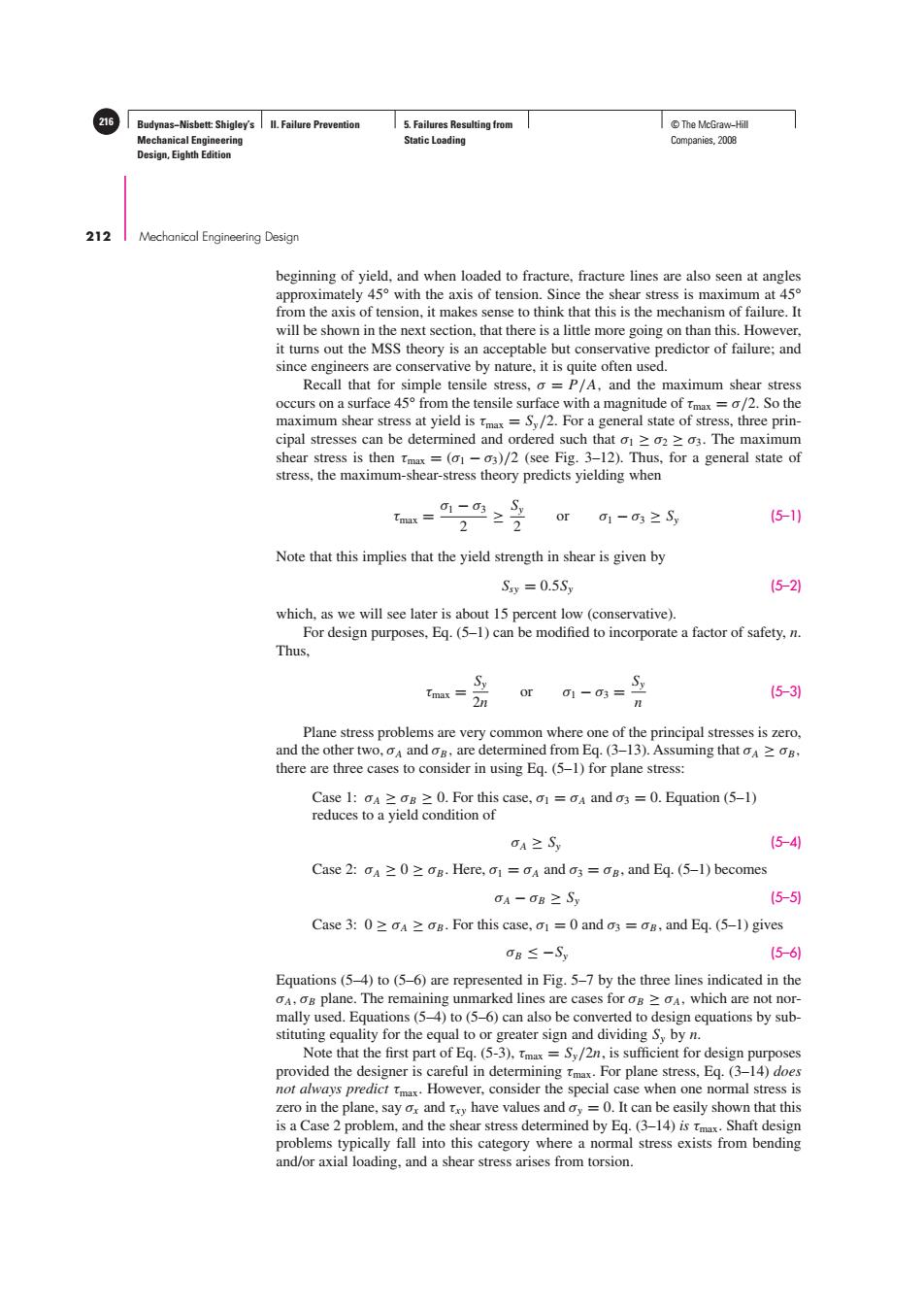正在加载图片...

216 Budynas-Nisbett:Shigley's ll.Failure Prevention 5.Failures Resulting from T©The McGraw-Hil Mechanical Engineering Static Loading Companies,2008 Design,Eighth Edition 212 Mechanical Engineering Design beginning of yield,and when loaded to fracture,fracture lines are also seen at angles approximately 45 with the axis of tension.Since the shear stress is maximum at 45 from the axis of tension,it makes sense to think that this is the mechanism of failure.It will be shown in the next section,that there is a little more going on than this.However, it turns out the MSS theory is an acceptable but conservative predictor of failure;and since engineers are conservative by nature,it is quite often used. Recall that for simple tensile stress,o P/A,and the maximum shear stress occurs on a surface 45 from the tensile surface with a magnitude of mx=/2.So the maximum shear stress at yield ismax=Sy/2.For a general state of stress,three prin- cipal stresses can be determined and ordered such that o1>02>03.The maximum shear stress is then tmax =(a1-03)/2(see Fig.3-12).Thus,for a general state of stress,the maximum-shear-stress theory predicts yielding when ax=-a、S, .22 0r01-3≥S (5-1) 2 Note that this implies that the yield strength in shear is given by Ssy =0.5Sy (5-21 which,as we will see later is about 15 percent low (conservative). For design purposes,Eq.(5-1)can be modified to incorporate a factor of safety,n. Thus, S Tmax or1-03=S (5-3) 2n Plane stress problems are very common where one of the principal stresses is zero, and the other two,A and og,are determined from Eq.(3-13).Assuming that A >og. there are three cases to consider in using Eq.(5-1)for plane stress: Case 1:A g0.For this case,o1 =A and o3 =0.Equation (5-1) reduces to a yield condition of OA≥S, (5-41 Case 2:A 202OB.Here,a1=A and o3=og,and Eq.(5-1)becomes A-OB Sy (5-51 Case 3:02A zog.For this case,o1=0 and o3 =aB,and Eq.(5-1)gives OB≤-S, (5-61 Equations (5-4)to (5-6)are represented in Fig.5-7 by the three lines indicated in the OA,og plane.The remaining unmarked lines are cases for og oA,which are not nor- mally used.Equations(5-4)to(5-6)can also be converted to design equations by sub- stituting equality for the equal to or greater sign and dividing S,by n. Note that the first part of Eq.(5-3).Tmx=Sy/2n.is sufficient for design purposes provided the designer is careful in determining Tmax.For plane stress,Eq.(3-14)does not always predict mx However,consider the special case when one normal stress is zero in the plane,say ox and xy have values andoy=0.It can be easily shown that this is a Case 2 problem,and the shear stress determined by Eg.(3-14)is tmax.Shaft design problems typically fall into this category where a normal stress exists from bending and/or axial loading,and a shear stress arises from torsion.Budynas−Nisbett: Shigley’s Mechanical Engineering Design, Eighth Edition II. Failure Prevention 5. Failures Resulting from Static Loading 216 © The McGraw−Hill Companies, 2008 212 Mechanical Engineering Design beginning of yield, and when loaded to fracture, fracture lines are also seen at angles approximately 45° with the axis of tension. Since the shear stress is maximum at 45° from the axis of tension, it makes sense to think that this is the mechanism of failure. It will be shown in the next section, that there is a little more going on than this. However, it turns out the MSS theory is an acceptable but conservative predictor of failure; and since engineers are conservative by nature, it is quite often used. Recall that for simple tensile stress, σ = P/A, and the maximum shear stress occurs on a surface 45° from the tensile surface with a magnitude of τmax = σ/2. So the maximum shear stress at yield is τmax = Sy/2. For a general state of stress, three principal stresses can be determined and ordered such that σ1 ≥ σ2 ≥ σ3. The maximum shear stress is then τmax = (σ1 − σ3)/2 (see Fig. 3–12). Thus, for a general state of stress, the maximum-shear-stress theory predicts yielding when τmax = σ1 − σ3 2 ≥ Sy 2 or σ1 − σ3 ≥ Sy (5–1) Note that this implies that the yield strength in shear is given by Ssy = 0.5Sy (5–2) which, as we will see later is about 15 percent low (conservative). For design purposes, Eq. (5–1) can be modified to incorporate a factor of safety, n. Thus, τmax = Sy 2n or σ1 − σ3 = Sy n (5–3) Plane stress problems are very common where one of the principal stresses is zero, and the other two, σA and σB, are determined from Eq. (3–13). Assuming that σA ≥ σB, there are three cases to consider in using Eq. (5–1) for plane stress: Case 1: σA ≥ σB ≥ 0. For this case, σ1 = σA and σ3 = 0. Equation (5–1) reduces to a yield condition of σA ≥ Sy (5–4) Case 2: σA ≥ 0 ≥ σB . Here, σ1 = σA and σ3 = σB , and Eq. (5–1) becomes σA − σB ≥ Sy (5–5) Case 3: 0 ≥ σA ≥ σB . For this case, σ1 = 0 and σ3 = σB , and Eq. (5–1) gives σB ≤ −Sy (5–6) Equations (5–4) to (5–6) are represented in Fig. 5–7 by the three lines indicated in the σA, σB plane. The remaining unmarked lines are cases for σB ≥ σA, which are not normally used. Equations (5–4) to (5–6) can also be converted to design equations by substituting equality for the equal to or greater sign and dividing Sy by n. Note that the first part of Eq. (5-3), τmax = Sy/2n, is sufficient for design purposes provided the designer is careful in determining τmax. For plane stress, Eq. (3–14) does not always predict τmax. However, consider the special case when one normal stress is zero in the plane, say σx and τxy have values and σy = 0. It can be easily shown that this is a Case 2 problem, and the shear stress determined by Eq. (3–14) is τmax. Shaft design problems typically fall into this category where a normal stress exists from bending and/or axial loading, and a shear stress arises from torsion